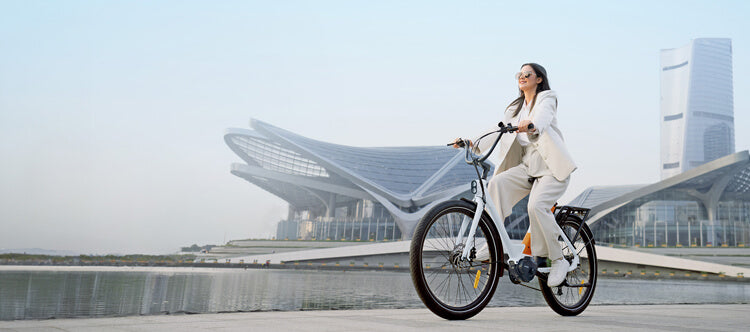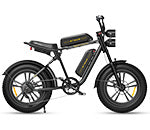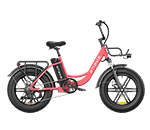Discover Electrically Assisted Pedal Cycles/EAPC Bikes
Electrically Assisted Pedal Cycles, or EAPC bikes, have been quietly revolutionizing the way we think about commuting and transportation. In a world increasingly concerned with sustainability, efficiency, and personal health, EAPCs stand out as a beacon of innovation. This blog delves deep into what EAPC electric bikes are, how they work, their myriad benefits, and the legalities surrounding their use. Whether you're a seasoned cyclist or new to the concept, join us in exploring the ins and outs of these amazing machines.
Understanding EAPCs
At its core, an EAPC is a bicycle that integrates an electric motor to assist with pedaling. Unlike traditional bicycles, which rely solely on the rider's physical exertion, or fully electric bikes, which can operate without pedaling, EAPCs strike a balance. They augment the rider's power, not replace it, making uphill climbs and long distances more manageable. EAPCs vary in power, range, and design, catering to different needs and preferences, from urban commuting to off-road adventures.
The Benefits of Riding an EAPC
EAPCs offer a range of benefits that have helped them become more and more popular with every passing year. With more innovation and advancements coming all the time, new e-bikes are getting faster, more efficient, and more accessible. So if you are thinking about getting a new bike and looking around Engwe Bikes for options, here are some benefits to keep in mind.
1. Environmental Benefits
Modern versions of EAPCs offer a significant reduction in carbon footprint when compared to gasoline-powered vehicles. By opting for an EAPC electric bike, riders contribute to lower emissions, helping combat air pollution and climate change.
2. Health Benefits
Riding an EAPC bike is a form of exercise, albeit less strenuous than traditional cycling. It's perfect for those looking to improve their fitness levels without overexerting themselves, providing a cardiovascular workout that can adapt to varying fitness levels.
3. Economic Benefits
With lower operating and maintenance costs compared to cars and public transportation, EAPC bikes are an economically savvy choice. They require no gasoline, have fewer mechanical parts that could break down, and parking is both easier and cheaper.
4. Convenience and Efficiency
EAPCs also offer a swift alternative to navigating through congested streets, with the added benefits of easy parking and suitability for short to medium distances. They bridge the gap between the speed of a motor vehicle and the flexibility of a bicycle.

Legal Regulations and Considerations
Navigating the legal landscape of Electrically Assisted Pedal Cycles (EAPCs) can be as complex as it is varied, with regulations that change not just from country to country but often from one local jurisdiction to another. Different approaches governments take towards integrating new modes of transportation today morphs into existing legal frameworks. Understanding these e-bike laws is not just a matter of compliance but of ensuring the safety of both the rider and those sharing the road.
1. Age Restrictions
Many jurisdictions have implemented age restrictions for EAPC riders to ensure that only those with a certain level of maturity and physical capability are operating these vehicles.
2. Helmet Laws
Helmet laws are another common regulatory feature, with many areas mandating their use for EAPC riders. Compliance with helmet laws is not just about avoiding fines but about protecting oneself from serious harm.
3. Maximum Power Limits
Laws often cap the maximum power output of the motor (e.g., 250 watts) and the speed at which the electric assist must cut off (e.g., 25 km/h or 15.5 mph). Exceeding these limits could reclassify the EAPC into a different legal category, such as a moped.
4. Insurance and Licensing
In jurisdictions where EAPCs are treated similarly to bicycles, there may be no need for a license or insurance. However, if the power or speed of an EAPC exceeds defined thresholds, it might be considered a motor vehicle, requiring different coverage.
5. Usage in Public Space
Where EAPCs can be ridden is another area governed by local laws. Some regions allow EAPCs on bike paths and trails, aiming to encourage their use as an eco-friendly transportation alternative. Others may restrict them to roads or specific bike lanes, especially if they are capable of higher speeds.
Choosing the Right EAPC Bike for You
Selecting an EAPC bike involves considering several factors, such as battery life, motor power, weight, and cost. Your choice should align with your needs, whether for commuting, leisure, fitness, or off-road use. Test riding different models is invaluable, providing insights into comfort, performance, and suitability.
EAPCs represent a fusion of technology, sustainability, and personal well-being. They offer a viable alternative to traditional modes of transportation, with benefits that extend beyond individual convenience to environmental conservation. As we've explored the workings, advantages, and legalities of EAPCs, it's clear that they are more than just a trend; they're a movement towards a cleaner, healthier, and more efficient future.
At Engwe Bikes we are proud of our collection of EAPC bikes. Some of our most popular models include:

This folding electric bike is equipped with a 48V13Ah removable internal lithium-ion battery, offering an impressive range of up to 120 kilometers on a single charge. It rolls on 20 x 4.0 fat tires, designed to handle a variety of terrains with ease. The bike's top speed is capped at 25 kilometers per hour, though it comes with the capability to be unlocked for greater speed. Recharging the battery is convenient and relatively swift, taking about 6.5 hours to reach full capacity, ensuring you can quickly get back on the road for your next adventure.
2. Engwe T14
This convenient electric folding bike features a 48V10AH lithium-ion battery that supports a range of up to 25 kilometers when used in electric mode and extends to 42 kilometers in pedal-assist (PAS) mode. The charging time for the battery falls between 6 to 8 hours, ensuring your bike is ready for daily commutes or leisurely rides without long downtimes. Additionally, it boasts a maximum climbing degree of 7°, allowing for smooth ascents on slight inclines, making it a versatile choice for both urban and light trail use.
3. Engwe L20
This step-through electric commuter bike comes equipped with a 48V13Ah lithium-ion battery, providing an exceptional maximum mileage of up to 140 kilometers. It offers a standard top speed of 25KM/H, which can be unlocked for greater velocity, making it versatile for various riding conditions. The bike can be fully recharged in approximately 6.5 hours, ensuring it's ready for extended adventures without long waits. Additionally, it's capable of handling inclines with a maximum climbing degree of 10°, offering ease of travel over hills and elevated terrain.
Final Thoughts on EAPC Rules and Use
We invite you to browse our selection of EAPC bikes and consider how they might enhance your daily commute or leisure activities. Whether you're seeking guidance, ready for a test ride, or simply curious, our team is here to assist. Share your experiences, tips, or questions about EAPCs in the comments or on social media. Let's embark on this journey towards sustainable transportation together. Check out the amazing bikes we have available here at Engwe Bikes and find the best EAPC bike for you and your unique needs.
You may also want to know:
Explore More About Men's Electric Bike
Best Fast Electric Bikes in UK (Within Max Speed Limits)
Best Cheap Electric Bikes in UK for 2024


























